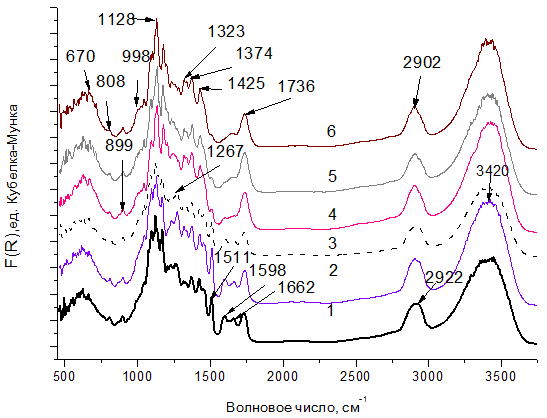DEGRADATION OF PINE WOOD STRUCTURE WHEN OZONOLYTIC DELIGNIFICATION
Abstract
The pine wood degradation under ozonation was studied. It was determined the contents of lignin (LG) and cellulose (CL) in cellulose-containing material (CM) obtained from the ozonized wood. The degree of polymerization (DP) of cellulose from CM was determined. Samples of CM were investigated using IR diffuse reflectance (DRIFT) spectra and XRD analysis. HPLC analysis of water-soluble LG ozonolysis products was conducted.
Ozonation results in 40–42% delignification degree of wood. Aromatics destruction is confirmed by DRIFT spectra. The intensity of stretching band at 1736 cm-1 of unconjugated C=O groups in LG or hemicelluloses markedly increases.
A stoichiometric ratio of absorbed ozone and an amount of destructed guaiacylpropane units as well as a composition of water-soluble products show that ozonolysis is a primary mechanism of aromatics degradation in wood.
The data on XRD analysis, the amounts of removed LG and the change of cellulose DP allow conclusion that the wood ozonation is accompanied by a destruction of hemicelluloses and amorphous cellulose in the wood.
It is shown that the specific ozone uptake £1.5 mmol O3/g matches the domination of the wood delignification with the lowest degradation of cellulose fibers and acceptable efficiency in terms of the ozonation process.
Downloads
Metrics
References
Bogolitsyn K.G. Rossiyskiy khimicheskiy zhurnal, 2004, vol. 48, no. 6, pp. 105–123. (in Russ.).
Brochier B., Kuligowski C., Voiron S., Petit-Conil M. Ozone news, 2006, vol. 34, no. 6, pp. 21–28.
Travaini R. Martín-Juárez J., Lorenzo-Hernando A., Bolado-Rodriges S. Biores. Technol., 2016, vol. 199, no. 1, pp. 2–10. DOI: 10 1016/j.biotech.2015.08.143.
Mamleeva N.A., Autlov S.A.;Bazarnova N.G, Lunin V.V. Russ. J. Bioorg. Chem., 2016, vol. 42, no. 7, pp. 694–699. DOI: 10.1134/S1068162016070098.
Mamleyeva N.A., Kustov A.L., Lunin V.V. Zhurnal fizicheskoy khimii, 2018, vol. 92, no. 9, pp. 1402–1408. DOI: 10.1134/S0036024418090182. (in Russ.).
Mamleeva N.A., Babayeva N.A., Kharlanov A.N., Lunin V.V. Russ. J. Phys. Chem. A, 2019, vol. 93, no. 1, pp. 37–42. DOI: 10.1134/S0044453719010199.
Ben’ko E.M., Manisova O.R., Lunin V.V. Russ. J. Phys. Chem. A., 2017, vol. 91, no. 7, pp. 1190–1196. DOI: 10.1134/s0036024417070056.
Andersen S.L.F., Castoldi R., Bracht A., Peralta R.A., Alves de Lima E., Helm C.V., Moreira R., Peralta R.M. Wood Sci. Technol., 2019, vol. 53, Issue 1, pp. 49–69. DOI: 10.1007/s00226-018-1061-7.
Li C., Wang L., Chen Z., Li Y., Wang R., Luo X., Cai G., Li Y., Yu Q., Lu J. Bioresour. Technol., 2015, vol. 183, no. 1, pp. 240–247. DOI: 10.1016/j.biortech.2015.01.042.
Obolenskaya A.V., Yel'nitskaya Z.P., Leonovich A.A. Laboratornyye raboty po khimii drevesiny i tsellyulozy. [Laborato-ry work on the chemistry of wood and cellulose]. Moscow, 1991, 320 p. (in Russ.).
Yu Z., Jameel H., Chang H., Park S. Biores. Technol., 2011, vol. 102, pp. 9083–9089. DOI: 10.1016/j.biortech.2011.07.001.
Segal L., Creely J.J., Martin.Jr. A.E., Conrad C.M. Tex. Res. J., 1959, vol. 29, no. 10, pp. 786–794. DOI: 10.1177%2F004051755902901003.
Schöne L., Herrmann H. Atmos. Chem. Phys., 2014, vol. 14, pp. 4503–4514. DOI: 10.5194/acp-14-4503-2014.
Razumovsky S.D., Zaikov G.E. Ozone and its reactions with organic compounds. Kinetics and mechanism. Amsterdam. The Nethelands. Elsevier. 1984.
Bailey P.S. Ozonation of Aromatic Compounds. in Ozonation in Organic Chemistry, vol. 2. Nonolefinic compounds. New York. 1982, pp. 31–37.
Pandey K.K., Theagarjan K.S. Holz als Roh- und Werkstoff., 1997, vol. 55, pp. 383–390. DOI: 10.1007/s00107005025.
Schwanninger M., Rodrigues J.C., Pereira H., Hinterstoisser B. Vibrational Spectroscopy, 2004, vol. 36, pp. 23–40. DOI: 1016/j.vibspec.2004.02.003.
Bazarnova N.G., Karpova Ye.V., Katrakov et al. Metody issledovaniya drevesiny i yeyo proizvodnykh. [Methods for studying wood and its derivatives]. Barnaul, 2002, 160 p. (in Russ.).
Faix O., Böttcher J.H. Holz als Roh- und Werkstoff., 1992, vol. 50, pp. 221–226.
Derkacheva O.Yu., Sukhov D.A. Macromol. Symp., 2008, vol. 265, no. 1, pp. 61–68. DOI: 10.1002/masy.200850507.
Proniewicz L. M., Paluszkiewicz C., Wesełucha-Birczyn´ska A., Baran´ski A., Dutka D. J. Mol. Structure, 2002, vol. 614, pp. 345–353. DOI: 10.1016/S0022-2860(02)00275-2.
Aleshina L.A., Glazkova S.V., Lugovskaya L.A., Podoynikova M.V., Fofanov A.D., Silina Ye.V. Khimiya rastitel'nogo syr'ya, 2001, no. 1, pp. 5–36. (in Russ.).
Park S., Baker J.O., Himmel M.E, Parilla P.A., Johnson D.K. Biotechnol. Biofuels., 2010, vol. 3, no. 10. DOI: 10.1186/1754-6834-3-10.
Baryshnikov S.V., Sharypov V.I., Zhizhayev A.M., Beregovtsova N.G., Kuznetsov B.N. J. Siberian Federal Univ. Chem., 2010, vol. 3, no. 2, pp. 120–127. (in Russ.).
Mamleeva N.A., Abrosimova G.E., Kharlanov A.N., Lunin V.V. Russ. J. Phys. Chem. A., 2013, vol. 87, no. 7, pp. 1102–1107. DOI: 10.1134/S0036024413070200.
Ragnar M., Eriksson T., Reitberger T. Holzforschung, 1999, vol. 53, no. 1, pp. 292–298. DOI: 10.1515/HF.1999.049.
Staehelin J., Hoigné J. Environ. Science Technol., 1982, vol. 16, no. 12, pp. 666–681. DOI: 10.1021/es00104a009.
Olkkonen C., Tylli Y., Forsskåhl I., Fuhrmann A., Hausalo T., Tamminen T., Hortling B., Janson J. Holzforschung, 2000, vol. 54, pp. 397–406. DOI: 10.1515/HF.2000.067.


This work is licensed under a Creative Commons Attribution 4.0 International License.
The authors, which are published in this journal, agree to the following conditions:
1. Authors retain the copyright to the work and transfer to the journal the right of the first publication along with the work, at the same time licensing it under the terms of the Creative Commons Attribution License, which allows others to distribute this work with the obligatory indication of the authorship of this work and a link to the original publication in this journal .
2. The authors retain the right to enter into separate, additional contractual agreements for the non-exclusive distribution of the version of the work published by this journal (for example, to place it in the university depository or to publish it in a book), with reference to the original publication in this journal.
3. Authors are allowed to post their work on the Internet (for example, in a university repository or on their personal website) before and during the review process of this journal, as this may lead to a productive discussion, as well as more links to this published work.











